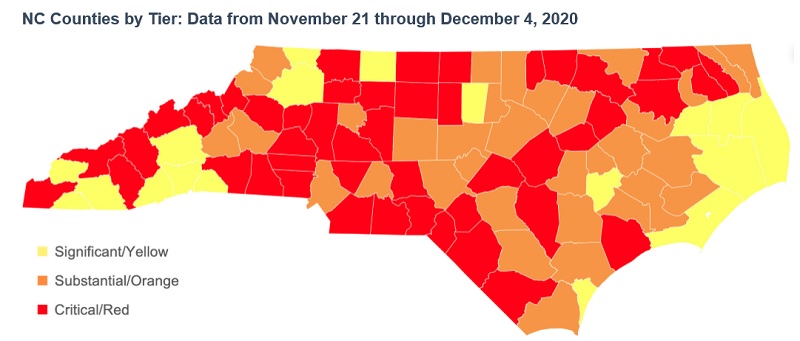
Order requires people to stay home from 10 p.m. to 5 a.m. with certain businesses required to close during those hours
Special to Iredell Free News
RALEIGH — Gov. Roy Cooper and N.C. Department of Health and Human Services Secretary Dr. Mandy Cohen announced Tuesday that North Carolina will begin a Modified Stay at Home Order after a rapid increase in North Carolina’s key COVID-19 trends.
The Order requires people to stay at home between 10 pm and 5 am and takes effect Friday, December 11, and will be in place until at least January 8, 2021.
“We already have strong safety protocols and capacity limitations in place – including a statewide mask requirement. With this additional action beginning Friday, we hope to get these numbers down,” Cooper said. “Our new modified Stay At Home order aims to limit gatherings and get people home where they are safer, especially during the holidays. It’s also a reminder that we must be vigilant the rest of the day – wearing a face mask when we are with people we don’t live with, keeping a safe distance from others and washing our hands a lot.”
The Order requires restaurants, bars, entertainment venues, personal care businesses and more to close at 10 pm.
Travel to and from work; to obtain food, medical care, fuel or social services; or to take care of a family member is exempted.
Read more in the Frequently Asked Questions. Read the Executive Order.
In the past week, North Carolina’s case count has broken single-day records on three separate days, including crossing more than 6,000 cases per day on two of those days. Just a month ago, cases were under 3,000 per day. In recent days, the percent of tests returning positive has increased to more than 10 percent.
Governor was clear that further action would be taken to slow the spread of the virus if trends do not improve. This could require further limiting of restaurant dining, indoor entertainment or shopping and retail capacity restrictions, among other safety protocols.
Dr. Cohen also provided an update on North Carolina’s COVID-19 County Alert System map:
♦ The number of red counties (critical community spread) has more than doubled since November 23, up to 48 red counties from 20 red counties.
♦ There are now 34 orange counties (substantial community spread), as compared to 42 orange counties from the previous report.
With today’s report, more than 80 percent of the state’s counties fall into the red or orange tier. Read the update to see where each county stands and how the system was designed.
“Your actions can keep people from getting sick, save lives, and make sure our hospitals can care for people whether it’s for a heart attack or a car accident or COVID-19. Protect yourself, your loved ones, and your community now,” Cohen said.
Iredell County Data
Iredell County is classified as a red county, with 594 positive cases per 100,000 people in the last 14 days. The county’s 14-day positive test rate is 12.8 percent, and the impact on local hospitals is deemed high. The number of hospitalizations has more than doubled during the past week, according to the Iredell County Health Department.
On Tuesday, Iredell health officials reported 182 new laboratory confirmed cases of COVID-19, increasing the county’s total to 6,586 cases. Seventy-deaths in Iredell have been attributed to the novel coronavirus, and 57 people are currently hospitalized.
Statewide Date
Cohen also provided an update on North Carolina’s data and trends:
♦ Trajectory in COVID-Like Illness (CLI) Surveillance Over 14 Days: North Carolina’s syndromic surveillance trend for COVID-like illness is increasing.
♦ Trajectory of Confirmed Cases Over 14 Days: North Carolina’s trajectory of cases is increasing.
♦ Trajectory in Percent of Tests Returning Positive Over 14 Days: North Carolina’s trajectory in percent of tests returning positive is increasing.
♦ Trajectory in Hospitalizations Over 14 Days: North Carolina’s trajectory of hospitalizations is increasing.
In addition to these metrics, the state continues building capacity to adequately respond to an increase in virus spread in testing, tracing and prevention.





WOW THESE ARE TRULY THE LAST DAYS AND WE CAN’T KEEP LOCKING PEOPLE UP BECAUSE AS YOU SEE THE CASES ARE CONTINUOUSLY RISING WITH OR WITHOUT MASKS. WE JUST NEED TO REALIZE THAT MAN CAN’T PREDICT THE FUTURE SO AT THE END OF THE DAY WE HAVE TO REALIZE THAT THIS TO SHALL PASS. WE HAVE TO STAY PRAYED UP, AND DON’T EVER LOSE OUR FAITH!